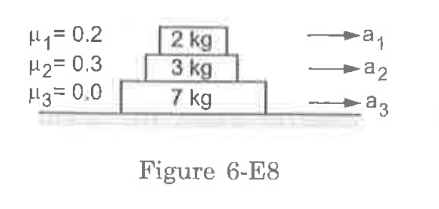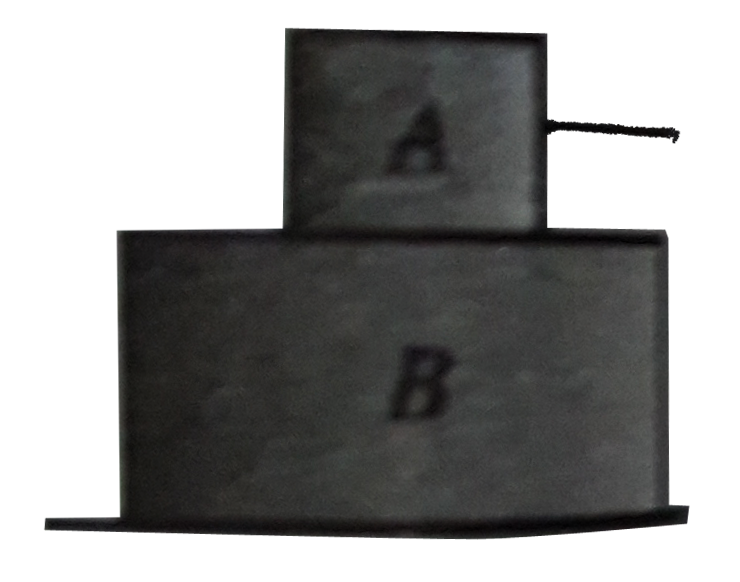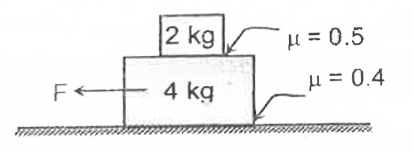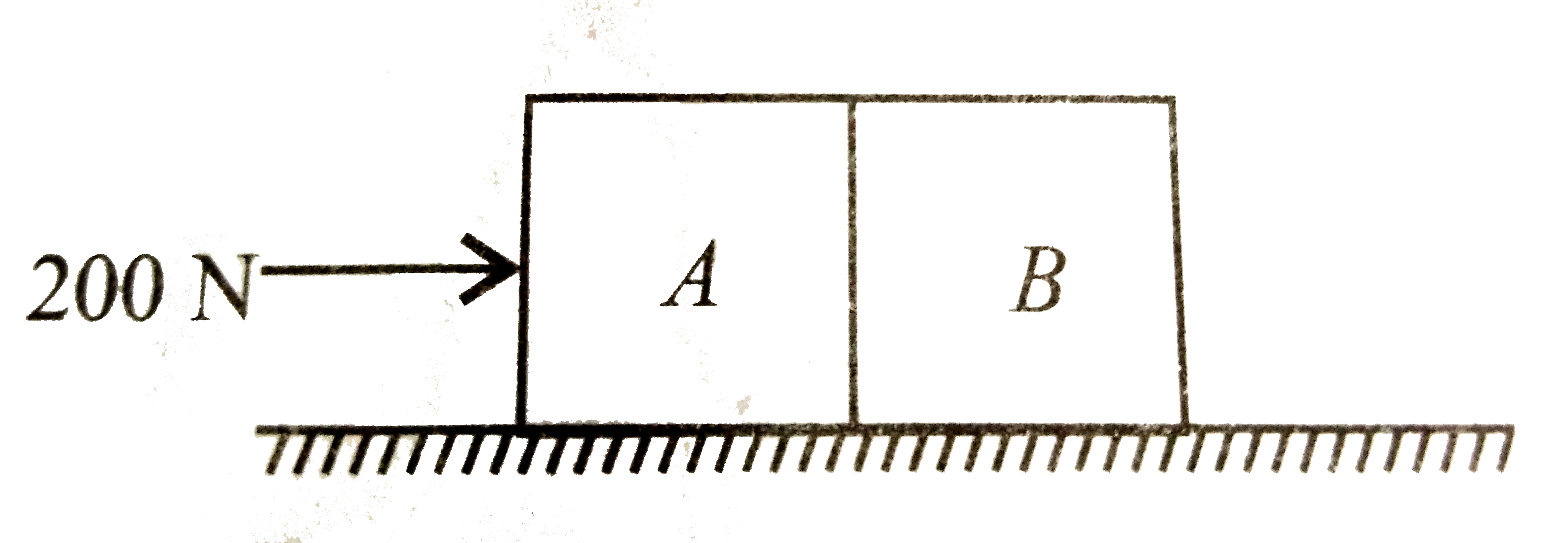A 2 kg block iks placed over a 4 kg block and both are plced on a smooth horizontal surfae. The coefficient of friction between the blocks is 0.20. Find theacceleration of the two blocks if a horizontal force os 12 N is applied to a. the upper block, b. the lower block. Take g=10ms2.
To solve the problem, we will analyze the two scenarios separately:
Part A: Force applied to the upper block
1. Identify the masses and forces:
- Mass of the upper block (m1) = 2 kg
- Mass of the lower block (m2) = 4 kg
- Coefficient of friction (μ) = 0.20
- Applied force (F) = 12 N
2. Calculate the maximum static friction:
- The normal force (N) acting on the upper block is equal to its weight:
N=m1⋅g=2kg⋅10m/s2=20N
- Maximum static friction (f_max) between the blocks:
fmax=μ⋅N=0.20⋅20N=4N
3. Assume both blocks move together:
- Total mass (M) = m1 + m2 = 2 kg + 4 kg = 6 kg
- Using Newton's second law:
F=M⋅a⟹12N=6kg⋅a⟹a=126=2m/s2
4. Check if the assumption holds:
- The frictional force required to accelerate the upper block at 2 m/s²:
f=m1⋅a=2kg⋅2m/s2=4N
- Since the required friction (4 N) equals the maximum static friction (4 N), the assumption that both blocks move together is valid.
Part B: Force applied to the lower block
1. Identify the forces acting on each block:
- The lower block (m2) experiences the applied force of 12 N and the friction force from the upper block opposing its motion.
- The upper block (m1) will experience the friction force trying to accelerate it.
2. Calculate the friction force:
- The friction force will be equal to the maximum static friction since the upper block will try to remain stationary relative to the lower block:
fmax=4N
3. Calculate the acceleration of the lower block:
- Using Newton's second law for the lower block:
F−fmax=m2⋅a2⟹12N−4N=4kg⋅a2
8N=4kg⋅a2⟹a2=84=2m/s2
4. Calculate the acceleration of the upper block:
- The upper block will experience the friction force which will try to accelerate it:
f=m1⋅a1⟹4N=2kg⋅a1⟹a1=42=2m/s2
Summary of Results
- Part A: When the force is applied to the upper block, both blocks accelerate together at 2 m/s².
- Part B: When the force is applied to the lower block, both blocks still accelerate at 2 m/s².
- Mass of the upper block (m1) = 2 kg
- Mass of the lower block (m2) = 4 kg
- Coefficient of friction (μ) = 0.20
- Applied force (F) = 12 N
- The normal force (N) acting on the upper block is equal to its weight:
N=m1⋅g=2kg⋅10m/s2=20N
- Maximum static friction (f_max) between the blocks:
fmax=μ⋅N=0.20⋅20N=4N
- Total mass (M) = m1 + m2 = 2 kg + 4 kg = 6 kg
- Using Newton's second law:
F=M⋅a⟹12N=6kg⋅a⟹a=126=2m/s2
- The frictional force required to accelerate the upper block at 2 m/s²:
f=m1⋅a=2kg⋅2m/s2=4N
- Since the required friction (4 N) equals the maximum static friction (4 N), the assumption that both blocks move together is valid.
- The lower block (m2) experiences the applied force of 12 N and the friction force from the upper block opposing its motion.
- The upper block (m1) will experience the friction force trying to accelerate it.
- The friction force will be equal to the maximum static friction since the upper block will try to remain stationary relative to the lower block:
fmax=4N
- Using Newton's second law for the lower block:
F−fmax=m2⋅a2⟹12N−4N=4kg⋅a2
8N=4kg⋅a2⟹a2=84=2m/s2
- The upper block will experience the friction force which will try to accelerate it:
f=m1⋅a1⟹4N=2kg⋅a1⟹a1=42=2m/s2
- Part A: When the force is applied to the upper block, both blocks accelerate together at 2 m/s².
- Part B: When the force is applied to the lower block, both blocks still accelerate at 2 m/s².
Topper's Solved these Questions
Similar Questions
A 3kg block is placed over a 10kg block and both are placed on a smooth horizontal surface. The coefficient of friction between the blocks is 0.2. IF a horizontal force of 20N is applied to 3kg block. Find the acceleration of the two blocks.

View SolutionFind the accelerations a1,a2,a3 of the three blocks shown in figure if a horizontal force of 10 N is applied on a. 2 kg block, b. 3 kg block, c. 7 kg block. Take g=10ms2.

View Solution
Knowledge Check
A 3 kg block is placed over a 10 kg block and both are palced on a smooth horizontal surface. The coefficient of friction between the block is 0.2 . If a horizontal force of 20 N is applied to 3 kg block, accelerations of the two block in ms−2 are (take, g=10ms−2)
 A134,0.6B144,3C134,3D143,0.6
A134,0.6B144,3C134,3D143,0.6A block of 5 kg is resting on a horizontal surface. The coefficient of kinetic friction between the block and the surface is 0.2. What is the acceleration with which the block will remove if a force of 9.8 N is applied to it ?
A2m/s2B3m/s2C1.5m/s2D2.5m/s2A block A of mass 2kg is placed over smooth block B of mass 4kg which is placed over a smooth horizontal floor The coefficient of friction between A and B is 0.4 when a horizontal forces of magnitude 10N is applied on A the acceleration of block of A and B are
 A1ms−2and2ms−2,respectivelyB5ms−2and2.5ms−2,respectivelyCBoth the block will moves together with acceleration 1/3ms−2DBoth the block will moves together with acceleration 5/3ms−2
A1ms−2and2ms−2,respectivelyB5ms−2and2.5ms−2,respectivelyCBoth the block will moves together with acceleration 1/3ms−2DBoth the block will moves together with acceleration 5/3ms−2
The coefficient of static friction between two blocks is 0.5 and the table is smooth. The maximum horizontal force that can be applied to move the blocks together is N. (take g=10ms−2)

View SolutionA block of mass 1 kg lies on a horizontal surface in a truck. The coefficient of static friction between the block and the surface is 0.6. If the acceleration of the truck is 5m/s2, the frictional force acting on the block is…………newtons.
View SolutionA block of mass m is kept over another block of mass 2m and the system rests on a smooth horizontal surface. The coefficient of friction between the block is 0.50. Find the work done by the force of friction on the smaller block by the bigger block during a displacement the of the system when a force mg is applied to the lower block
View SolutionConsider the arrangement shown in the figure. The coefficient of friction between the two blocks is 0.5 and between the 4 kg block and the horizontal surface is 0.4. If a horizontal force of 12 N is applied on the 4 kg block, the acceleration of the 2 kg block would be

View SolutionTwo blocks A and B of masses 10 kg and 15 kg are placed in contact with each other rest on a rough horizontal surface as shown in the figure. The coefficient of friction between the blocks and surface is 0.2. A horizontal force of 200 N is applied to block A. The acceleration of the system is (Take g=10ms−2)

View Solution
